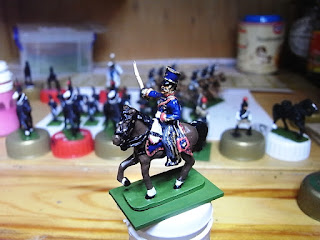Born in 1768, Padget commanded a regiment of volunteers in Flanders in 1794 and went on to lead a cavalry brigade in Holland in 1799. He became colonel of the 7th Light Dragoons and was appointed commander of the cavalry under Moore in the peninsular at the end of 1808. He conducted a skilful rearguard action during the retreat on Corunna (during which he captured the French commander Lefebvre-desnouettes).
Padget never returned to the peninsular to fight under Wellesley and this may have been partly due to the fact that he eloped with Wellesley’s sister. Bruce Quarrie in his book Napoleons Campaigns in Miniature says “In a wargames campaign I strongly recommend the British player bend the rules slightly and appoint him (Uxbridge) cavalry commander under Wellesley in Spain”. I’m not sure if Sir Stapleton-Cotton would have agreed with this suggestion.
During the 100 days campaign Padget, now Earl of Uxbridge, commanded the entire Anglo- Allied cavalry contingent and was second in command to Wellington. His magnificent rearguard action following Quatre Bras was perhaps the high point of his career. He famously lost a leg to a stray cannon ball during the closing phase of the battle of Waterloo. Padget lived on to become Marquis of Anglesy and a Field Marshal, he died in 1854.
Hinton Hunt BN/252 Lieut-Gen. The Earl of Uxbridge in hussar uniform and shako – painted by Matt G.


9 comments:
Great looking figure; didn't know about the elopement with the future Duke's sister :)
Dean - yes it must have been shocking stuff at the time!
Lovely figure, best commander of British cavalry at the time, are those French lancers in the background?
Paul
Hi Paul - immediately behind are the Carabiniers I'm currently working on. Right at the back are some British Light Dragoons - more on them soon!
Nice addition to the General Staff - I'm all in favour of Quarrie's theory of bending history a bit - I do it all the time. The French player in the Peninsula is also recommended to declare that the Danube and the Russian campaigns never happened, so that Napoleon, Davout, Murat, etc etc are available to fight in Spain throughout the war.
I've always been intrigued by this uniform for the HH Uxbridge - naturally, I know very little about this, but I am aware of Pieneman's famous painting of the Marquess of Anglesey (as he had then become) at Waterloo, which was commissioned by the man himself, and posed with great enthusiasm, though some 5 years after the event. Pieneman's picture shows exactly this uniform - I always wondered, is Uxbridge dressed as colonel of 7th LD/Hussars or is there some other explanation? Hinton Hunt's model of Stapleton Cotton shows the hussar style dress of a British general of cavalry, which might have been a possible outfit for Uxbridge on 18th June. It really doesn't matter - I'm sure this is the right uniform, I just wonder what he was dressed as?
Tony - interesting, the one thing we know about Marcus was that he really knew his stuff when it came to uniforms. At the same time though there are anomalies such as giving Picton a top hat and red coat when all accounts say he wore a plain riding coat at Waterloo.
Sorry Ian - I had meant to put a link to the Pieneman picture, which is a bit redundant anyway, but here it is:
http://en.wikipedia.org/wiki/Henry_Paget,_1st_Marquess_of_Anglesey#/media/File:Henry_William_Paget_00.jpg
Regards - Tony
Lovely work. Congratulations to you and to Matt
Thanks, but I think mostly it should go to Matt!
Post a Comment